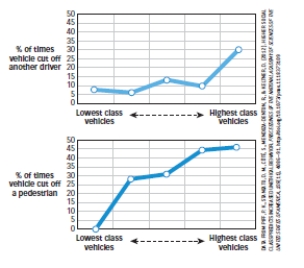Use the following to answer questions
Scenario I
Scenario I is based on and presents data from the following study (reproduced from p.25 of the textbook) :
Piff,P.K. ,Stancato,D.M. ,Côté,S. ,Mendoza-Denton,R. ,& Keltner,D.(2012) .Higher social class predicts increased unethical behavior.PNAS Proceedings of the National Academy of Sciences of the United States of America,109(11) ,4086-4091.doi:10.1073/pnas.1118373109
Piff and colleagues (2012) used naturalistic observation techniques to determine if wealthy people behaved more or less ethically than people who were not wealthy.In one study,observers stood at a busy intersection and recorded the make,model,and year of each approaching car.They also noted if the car cut off other cars or pedestrians at this intersection.
Major findings of Piff et al.(2012) are presented in Figure 1.1.This figure shows the percentage of times vehicles cut off another driver (top panel) or pedestrians (lower panel) as a function of the social status of the vehicles (with more expensive cars ranked higher in social status) .
Figure 1.1 
-(Scenario I) Based on the results shown in Figure 1.1,it is NOT known if:
A) people driving higher-class cars were less likely to yield to pedestrians.
B) drivers in general were more likely to yield to another car than to a pedestrian.
C) wealth caused people to care more about themselves than about others.
D) wealth was associated with selfish driving behavior.
Correct Answer:
Verified
Q1: Use the following to answer questions
Scenario
Q2: Use the following to answer questions
Scenario
Q4: Use the following to answer questions
Scenario
Q5: Use the following to answer questions
Scenario
Q6: Use the following to answer questions
Scenario
Q7: Use the following to answer questions
Scenario
Q8: Use the following to answer questions
Scenario
Q9: Use the following to answer questions
Scenario
Q10: Use the following to answer questions
Scenario
Q11: Use the following to answer questions
Scenario
Unlock this Answer For Free Now!
View this answer and more for free by performing one of the following actions

Scan the QR code to install the App and get 2 free unlocks

Unlock quizzes for free by uploading documents